Recent Advances in Two-Dimensional Materials with Charge Density Waves: Synthesis, Characterization and Applications
Abstract
:1. Introduction
2. Synthesis of 2D CDW Materials
2.1. Mechanical Exfoliation of Bulk Materials
2.2. Liquid Exfoliation Method
2.3. Chemical Vapor Transport
2.4. Chemical Vapor Deposition
2.5. Molecular Beam Epitaxy
3. Characterization of 2D CDW Materials
3.1. Raman Spectroscopic Characterization
3.2. Temperature-Dependent Resistivity and Magnetic Susceptibility
3.3. Scanning Tunneling Microscopic Characterization
4. Applications of CDW Materials
4.1. Electrodes in Supercapacitors
4.2. Charge Density Wave-Based Oscillator
4.3. Photodetector
4.4. Nonvolatile Memory
5. Sample Oxidation and Substrate Effect on CDW Transition
6. CDW Alloys
7. Conclusions
Acknowledgments
Author Contributions
Conflicts of Interest
References
- Geim, A.K.; Grigorieva, I.V. Van der Waals heterostructures. Nature 2013, 499, 419–425. [Google Scholar] [CrossRef] [PubMed]
- Chhowalla, M.; Shin, H.S.; Eda, G.; Li, L.J.; Loh, K.P.; Zhang, H. The chemistry of two-dimensional layered transition metal dichalcogenide nanosheets. Nat. Chem. 2013, 5, 263–275. [Google Scholar] [CrossRef] [PubMed]
- Renteria, J.; Samnakay, R.; Jiang, C.; Pope, T.R.; Goli, P.; Yan, Z.; Wickramaratne, D.; Salguero, T.T.; Khitun, A.G.; Lake, R.K.; et al. All-metallic electrically-gated tantalum diselenide switches and logic circuits. J. Appl. Phys. 2014, 115, 034305. [Google Scholar] [CrossRef]
- Xu, K.; Chen, P.; Li, X.; Wu, C.; Guo, Y.; Zhao, J.; Wu, X.; Xie, Y. Ultrathin nanosheets of vanadium diselenide: a metallic two-dimensional material with ferromagnetic charge-density-wave behavior. Angew. Chem. Int. Ed. 2013, 52, 10477–10481. [Google Scholar] [CrossRef] [PubMed]
- Gomez, A.C.; Moratalla, E.N.; Guillermo, M.G.; Jorge, Q.J.; Cienfuegos, E.P.; Agraït, N.; Van der Zant, H.J.; Coronado, E.; Steele, G.A.; Bollinger, G.R. Fast and reliable identification of atomically thin layers of TaSe2 crystals. Nano Res. 2013, 6, 191–199. [Google Scholar] [CrossRef]
- Buscema, M.; Barkelid, M.; Zwiller, V.; Van der Zant, H.S.G.; Steele, G.A.; Castellanos, G.A. Large and tunable photothermoelectric effect in single-layer MoS2. Nano Lett. 2013, 13, 358–363. [Google Scholar] [CrossRef] [PubMed]
- Wickramaratne, D.; Zahid, F.; Lake, R.K. Electronic and thermoelectric properties of few-layer transition metal dichalcogenides. J. Chem. Phys. 2014, 140, 124710. [Google Scholar] [CrossRef] [PubMed] [Green Version]
- Renteria, J.; Samnakay, R.; Rumyantsev, S.L.; Jiang, C.; Goli, P.; Shur, M.S.; Balandin, A.A. Low-frequency 1/f Noise in molybdenum disulfide transistors. Appl. Phys. Lett. 2014, 104, 153104. [Google Scholar] [CrossRef]
- Taniguchi, K.; Matsumoto, A.; Shimotani, H.; Takagi, H. Electric-field-induced superconductivity at 9.4 K in a layered transition metal disulphide MoS2. Appl. Phys. Lett. 2012, 101, 042603. [Google Scholar] [CrossRef]
- Xi, X.; Zhao, L.; Wang, Z.; Berger, H.; Forró, L.; Shan, J.; Mak, K.F. Strongly enhanced charge-density-wave order in monolayer NbSe2. Nat. Nanotechnol. 2015, 10, 765–769. [Google Scholar] [CrossRef] [PubMed]
- Goli, P.; Khan, J.; Wickramaratne, D.; Lake, R.K.; Balandin, A.A. Charge density waves in exfoliated films of van der waals materials: Evolution of Raman spectrum in TiSe2. Nano Lett. 2012, 12, 5941–5945. [Google Scholar] [CrossRef] [PubMed]
- Gruner, G. The dynamics of charge-density waves. Rev. Mod. Phys. 1988, 60, 1129–1175. [Google Scholar] [CrossRef]
- Adelman, T.L.; Zaitsev-Zotov, S.V.; Thorne, R.E. Field-effect modulation of charge-density-wave transport in NbSe3 and TaS3. Phys. Rev. Lett. 1995, 74, 5264–5267. [Google Scholar] [CrossRef] [PubMed]
- Zaitsev-Zotov, S.V. Finite-size effects in quasi-one-dimensional conductors with a charge-density wave. Phys. Usp. 2004, 47, 533–553. [Google Scholar] [CrossRef]
- Moncton, D.E.; Axe, J.D.; DiSalvo, F.J. Study of superlattice formation in 2H-NbSe2 and 2H-TaSe2 by neutron Sscattering. Phys. Rev. Lett. 1975, 34, 734–737. [Google Scholar] [CrossRef]
- Fleming, R.M.; Schneemeyer, L.F.; Moncton, D.E. Commensurate-incommensurate transition in the charge-density-wave state of K0.30MoO3. Phys. Rev. B 1985, 31, 899–903. [Google Scholar] [CrossRef]
- Chu, C.W.; Testardi, L.R.; DiSalvo, F.J.; Moncton, D.E. Pressure effects on the charge-density-wave phases in 2H−TaSe2. Phys. Rev. B 1976, 14, 464–467. [Google Scholar] [CrossRef]
- Monney, C.; Battaglia, C.; Cercellier, H.; Aebi, P.; Beck, H. Exciton condensation driving the periodic lattice distortion of 1T−TiSe2. Phys. Rev. Lett. 2011, 106, 106404. [Google Scholar] [CrossRef] [PubMed]
- Bovet, M.; Popović, D.; Clerc, F.; Koitzsch, C.; Probst, U.; Bucher, E.; Berger, H.; Naumović, D.; Aebi, P. Pseudogapped Fermi surfaces of 1T-TaS2 and 1T-TaSe2: A charge density wave effect. Phys. Rev. B 2004, 69, 125117. [Google Scholar] [CrossRef]
- Arguello, C.J.; Chockalingam, S.P.; Rosenthal, E.P.; Zhao, L.; Gutiérrez, C.; Kang, J.H.; Chung, W.C.; Fernandes, R.M.; Jia, S.; Millis, A.J.; et al. Visualizing the charge density wave transition in 2H-NbSe2 in real space. Phys. Rev. B 2014, 89, 235115. [Google Scholar] [CrossRef]
- Mulazzi, M.; Chainani, A.; Katayama, N.; Eguchi, R.; Matsunami, M.; Ohashi, H.; Senba, Y.; Nohara, M.; Uchida, M.; Takagi, H.; et al. Absence of nesting in the charge-density-wave system 1T-VS2 as seen by photoelectron spectroscopy. Phys. Rev. B 2010, 82, 075130. [Google Scholar] [CrossRef]
- Tissen, V.G.; Osorio, M.R.; Brison, J.P.; Nemes, N.M.; Garcia-Hernandez, M.; Cario, L.; Rodiere, P.; Vieira, S.; Suderow, H. Pressure dependence of superconducting critical temperature and upper critical field of 2H-NbS2. Phys. Rev. B 2013, 87, 134502. [Google Scholar] [CrossRef]
- Dash, J.K.; Chen, L.; Dinolfo, P.H.; Lu, T.M.; Wang, G.C. A method toward fabricating semiconducting 3R-NbS2 ultrathin films. J. Phys. Chem. C 2015, 119, 19763–19771. [Google Scholar] [CrossRef]
- Valla, T.; Fedorov, A.V.; Johnson, P.D.; Glans, P.A.; McGuinness, C.; Smith, K.E.; Andrei, E.Y.; Berger, H. Quasiparticle spectra, charge-density waves, superconductivity, and electron-phonon coupling in 2H-NbSe2. Phys. Rev. Lett. 2004, 92, 086401. [Google Scholar] [CrossRef] [PubMed]
- Li, L.J.; Lu, W.J.; Liu, Y.; Qu, Z.; Ling, L.S.; Sun, Y.P. Influence of defects on charge-density-wave and superconductivity in 1T-TaS2 and 2H-TaS2 systems. Physica. C 2013, 492, 64–67. [Google Scholar] [CrossRef]
- Yu, Y.; Yang, F.; Lu, X.F.; Yan, Y.J.; Cho, Y.H.; Ma, L.; Niu, X.; Kim, S.; Son, Y.W.; Feng, D.; et al. Gate-tunable phase transitions in thin flakes of 1T-TaS2. Nat. Naotechnol. 2015, 10, 270–276. [Google Scholar] [CrossRef] [PubMed]
- Cao, Y.F.; Cai, K.M.; Li, L.J.; Lu, W.J.; Sun, Y.P.; Wang, K.Y. Transport and capacitance properties of charge density wave in few layer 2H-TaS2 devices. Chin. Phys. Lett. 2014, 31, 077203. [Google Scholar] [CrossRef]
- Samnakay, R.; Wickramaratne, D.; Pope, R.; Lake, R.K.; Salguero, T.T.; Balandin, A.A. Zone-folded phonons and the commensurate incommensurate charge-density-wave transition in 1T-TaSe2 thin films. Nano Lett. 2015, 15, 2965–2973. [Google Scholar] [CrossRef] [PubMed]
- Luo, H.X.; Xie, W.W.; Tao, J.; Inoue, H.; Gyenis, A.; Krizan, J.W.; Yazdani, A.; Zhu, Y.M.; Cava, R.J. Polytypism, polymorphism, and superconductivity in TaSe2−XTeX. Proc. Natl. Acad. Sci. USA 2015, 112, E1174–E1180. [Google Scholar] [CrossRef] [PubMed]
- Dardel, B.; Grioni, M.; Malterre, D.; Weibel, P.; Baer, Y.; Levy, F. Spectroscopic observation of charge-density-wave-induced changes in the electronic structure of 2H-TaSe2. J. Phys. Condens. Matter 1993, 5, 6111–6120. [Google Scholar] [CrossRef]
- Hajiyev, P.; Cong, C.; Qiu, C.; Yu, T. Contrast and Raman spectroscopy study of single- and few-layered charge density wave material: 2H-TaSe2. Sci. Rep. 2013, 3, 2593. [Google Scholar] [CrossRef] [PubMed]
- Morosan, E.; Zandbergen, H.W.; Dennis, B.S.; Bos, J.W.G.; Onose, Y.; Klimczuk, T.; Ramirez, A.P.; Ong, N.P.; Cava, R.J. Superconductivity in CuXTiSe2. Nat. Phys. 2006, 2, 544. [Google Scholar] [CrossRef]
- Liu, Y.; Ang, R.; Lu, W.J.; Song, W.H.; Li, L.J.; Sun, Y.P. Superconductivity induced by Se-doping in layered charge-density-wave system 1T-TaS2–XSeX. Appl. Phys. Lett. 2013, 102, 192602. [Google Scholar] [CrossRef]
- Tao, W.H.; Jun, L.L.; Shu, Y.D.; Hong, C.X.; An, X.Z. Effect of Te doping on superconductivity and charge-density wave in dichalcogenides 2H-NbSe2-XTeX (X = 0, 0.1, 0.2). Chin. Phys. Soc. 2007, 16, 2471–2474. [Google Scholar]
- Ang, R.; Tanaka, Y.; Ieki, E.; Nakayama, K.; Sato, T.; Li, L.J.; Lu, W.J.; Sun, Y.P.; Takahashi, T. Real-space coexistence of the melted mott state and superconductivity in Fe-substituted 1T−TaS2. Phys. Rev. Lett. 2012, 109, 176403. [Google Scholar] [CrossRef] [PubMed]
- Kusmartseva, A.F.; Sipos, B.; Berger, H.; Forro, L.; Tutis, E. Pressure induced superconductivity in pristine 1T-TiSe2. Phys. Rev. Lett. 2009, 103, 236401. [Google Scholar] [CrossRef] [PubMed]
- Liu, G.; Debnath, B.; Pope, T.R.; Salguero, T.T.; Lake, R.K.; Balandin, A.A. A charge-density-wave oscillator based on an integrated tantalum disulfide–boron nitride–graphene device operating at room temperature. Nat. Nanotechnol. 2016, 11, 845–850. [Google Scholar] [CrossRef] [PubMed]
- Vaskivskyi, I.; Mihailovic, I.A.; Brazovskii, S.; Gospodaric, J.; Mertelj, T.; Svetin, D.; Sutar, P.; Mihailovic, D. Fast electronic resistance switching involving hidden charge density wave states. Nat. Commun. 2016, 7, 11442. [Google Scholar] [CrossRef] [PubMed]
- Stojchevska, L.; Vaskivskyi, I.; Mertelj, T.; Kusar, P.; Svetin, D.; Brazovskii, S.; Mihailovic, D. Ultrafast switching to a stable hidden quantum state in an electronic crystal. Science 2014, 344, 177–180. [Google Scholar] [CrossRef] [PubMed]
- Frindt, R.F. Superconductivity in Ultrathin NbSe2 Layers. Phys. Rev. Lett. 1972, 26, 299–301. [Google Scholar] [CrossRef]
- Moratalla, E.N.; Island, J.O.; Valero, S.M.; Cienfuegos, E.P.; Gomez, A.C.; Quereda, J.; Bollinger, G.R.; Chirolli, L.; Guillén, J.A.S.; Agraït, N.; et al. Enhanced superconductivity in atomically thin TaS2. Nat. Commun. 2016, 7, 11043. [Google Scholar] [CrossRef] [PubMed]
- Li, H.; Lu, G.; Wang, Y.; Yin, Z.; Cong, C.; He, Q.; Wang, L.; Ding, F.; Yu, T.; Hua, Z. Mechanical exfoliation and characterization of single- and few-layer nanosheets of WSe2, TaS2, and TaSe2. Small 2013, 9, 1974–1981. [Google Scholar] [CrossRef] [PubMed]
- El-Bana, M.S.; Wolverson, D.; Russo, S.; Balakrishnan, G.; Paul, D.M.; Simon, J.B. Superconductivity in two-dimensional NbSe2 field effect transistors. Supercond. Sci. Technol. 2013, 26, 125020. [Google Scholar] [CrossRef]
- Feng, J.; Sun, X.; Wu, C.; Peng, L.; Lin, C.; Hu, S.; Yang, J.; Xie, Y. Metallic few-layered VS2 ultrathin nanosheets: High two-dimensional conductivity for in-plane supercapacitors. J. Am. Chem. Soc. 2011, 133, 17832–17838. [Google Scholar] [CrossRef] [PubMed]
- Zeng, Z.; Tan, C.; Huang, X.; Bao, S.; Zhang, H. Growth of noble metal nanoparticles on single layer TiS2 and TaS2 nanosheets for hydrogen evolution reaction. Energy Environ. Sci. 2014, 7, 797–803. [Google Scholar] [CrossRef]
- Coleman, J.N.; Lotya, M.; O’Neill, A.; Bergin, S.D.; King, P.J.; Khan, U.; Young, K.; Gaucher, A.; De, S.; Smith, R.J.; et al. Two-Dimensional nanosheets produced by liquid exfoliation of layered materials. Science 2011, 331, 568–571. [Google Scholar] [CrossRef] [PubMed]
- Shiogai, J.; Ito, Y.; Mitsuhashi, T.; Nojima, T.; Tsukazaki, A. Electric-field-induced superconductivity in electrochemically etched ultrathin FeSe films on SrTiO3 and MgO. Nat. Phys. 2016, 12, 42–46. [Google Scholar] [CrossRef]
- Yoshida, M.; Ye, J.; Terukazu, N.; Norio, K.; Yoshihiro, I. Electrostatic and electrochemical tuning of superconductivity in two-dimensional NbSe2 crystals. App. Phys. Lett. 2016, 108, 202602. [Google Scholar] [CrossRef]
- Le’vy, F. Crystallography and Crystal Chemistry of Materials with Layered Structure; D. Reidel Publishing Company: Dordrecht, The Netherlands, 1976; Volume 2. [Google Scholar]
- Yang, J.; Wang, W.; Liu, Y.; Du, H.; Ning, W.; Zheng, G.; Jin, C.; Han, Y.; Wang, N.; Yang, Z.; et al. Thickness dependence of the charge-density-wave transition temperature in VSe2. Appl. Phys. Lett. 2014, 105, 063109. [Google Scholar] [CrossRef]
- Yan, Z.; Jiang, C.; Pope, T.R.; Tsang, C.F.; Stickney, J.L.; Goli, P.; Renteria, J.; Salguero, T.T.; Balandin, A.A. Phonon and thermal properties of exfoliated TaSe2 thin films. J. Appl. Phys. 2013, 114, 204301. [Google Scholar] [CrossRef]
- Huang, Y.H.; Chen, R.S.; Zhang, J.R.; Huang, Y.S. Electronic transport in NbSe2 two-dimensional nanostructures: Semiconducting characteristics and photoconductivity. Nanoscale 2015, 7, 18964–18970. [Google Scholar] [CrossRef] [PubMed]
- Wang, J.; Zheng, H.; Xu, G.; Sun, L.; Hu, D.; Lu, L.; Liu, L.; Zheng, J.; Tao, C.; Jiao, L. Controlled synthesis of two-dimensional 1T-TiSe2 with charge density wave transition by chemical vapor transport. J. Am. Chem. Soc. 2016, 138, 16216–16219. [Google Scholar] [CrossRef] [PubMed]
- Choy, K.L. Chemical vapour deposition of coatings. Prog. Mater. Sci. 2003, 48, 57–170. [Google Scholar] [CrossRef]
- Hou, X.; Choy, K.L. Processing and applications of aerosol-assisted chemical vapor deposition. Chem. Vap. Deposition 2006, 12, 583–596. [Google Scholar] [CrossRef]
- Yuan, J.; Wu, J.; Hardy, W.J.; Loya, P.; Lou, M.; Yang, Y.; Najmaei, S.; Jiang, M.; Qin, F.; Keyshar, K.; et al. Facile synthesis of single crystal vanadium disulfide nanosheets by chemical vapor deposition for efficient hydrogen evolution reaction. Adv. Mater. 2015, 27, 5605–5609. [Google Scholar] [CrossRef] [PubMed]
- Ji, Q.; Li, C.; Wang, J.; Niu, J.; Gong, Y.; Zhang, Z.; Fang, Q.; Zhang, Y.; Shi, J.; Liao, L.; et al. Metallic vanadium disulfide nanosheets as a platform material for multifunctional electrode applications. Nano Lett. 2017, 17, 4908–4916. [Google Scholar] [CrossRef] [PubMed]
- Nicolas, D.B.; Christopher, S.B.; Claire, J.C.; Ivan, P.P.; Prieto, A.G. Atmospheric pressure chemical vapour deposition of vanadium diselenide thin films. App. Surf. Sci. 2007, 253, 6041–6046. [Google Scholar]
- Zhang, Z.; Niu, J.; Yang, P.; Gong, Y.; Ji, Q.; Shi, J.; Fang, Q.; Jiang, S.; Li, H.; Zhou, X. Van der waals epitaxial growth of 2D metallic vanadium diselenide single crystals and their extra-high electrical conductivity. Adv. Mater. 2017, 1702359. [Google Scholar] [CrossRef] [PubMed]
- Wang, X.; Lin, J.; Zhu, Y.; Luo, C.; Suenaga, K.; Cai, C.; Xie, L. Chemical vapor deposition of trigonal prismatic NbS2 monolayer and 3R-polytype few-Layers. Nanoscale 2017. in revision. [Google Scholar]
- Wang, H.; Huang, X.; Lin, J.; Cui, J.; Chen, Y.; Zhu, C.; Liu, F.; Zeng, Q.; Zhou, J.; Yu, P.; et al. High-quality monolayer superconductor NbSe2 grown by chemical vapour deposition. Nat. Commun. 2017, 8, 394. [Google Scholar] [CrossRef] [PubMed]
- Fu, W.; Chen, Y.; Lin, J.; Wang, X.; Zheng, Q.; Zhou, J.; Zheng, L.; Wang, H.; He, Y.; Fu, Q.; et al. Controlled synthesis of atomically thin 1T-TaS2 for tunable charge density wave phase transitions. Chem. Mater. 2016, 28, 7613–7618. [Google Scholar] [CrossRef]
- Jin, G.; Kim, C.; Jo, H.; Kwon, S.H.; Jeong, S.J.; Lee, H.B.R.; Ahn, J.H. Vapor phase synthesis of TaS2 nanocrystals with iodine as transport agent. Jpn. J. Appl. Phys. 2017, 56, 045501. [Google Scholar] [CrossRef]
- Boscher, N.D.; Carmalt, C.J.; Parkin, I.P. Atmospheric pressure CVD of TiSe2 thin films on glass. Chem. Vap. Deposition 2006, 12, 54–58. [Google Scholar] [CrossRef]
- Bae, S.; Kim, H.; Lee, Y.; Xu, X.; Park, J.S.; Zheng, Y.; Balakrishnan, J.; Lei, T.; Kim, H.R.; Song, Y.I.; et al. Roll-to-roll production of 30-inch graphene films for transparent electrodes. Nat. Nanotechnol. 2010, 5, 574–578. [Google Scholar] [CrossRef] [PubMed]
- Jun, P.P.; Guan, J.Q.; Zhang, H.M.; Song, C.L.; Wang, L.; He, K.; Xue, Q.K.; Ma, X.C. Molecular beam epitaxy growth and scanning tunneling microscopy study of TiSe2 ultrathin films. Phys. Rev. B 2015, 91, 12113. [Google Scholar]
- Nishikawa, H.; Shimada, T.; Koma, A. Epitaxial growth of TiSe2 thin films on Se-terminated GaAs(111)B. J. Vacuu. Sci. Tech. A 1996, 14, 2893. [Google Scholar] [CrossRef]
- Ugeda, M.M.; Bradley, A.J.; Zhang, Y.; Onishi1, S.; Chen, Y.; Ruan, W.; Aristizaba, C.O.; Ryu, H.; Mark, T.; Edmonds, M.T.; et al. Characterization of collective ground states in single-layer NbSe2. Nat. Phys. 2016, 12, 92–97. [Google Scholar] [CrossRef]
- Koma, A.; Sunouchi, K.; Miyajima, T. Electronic structure of a monolayer NbSe2 film grown heteroepitaxially on the cleaved face of 2H-MoS2. In Proceedings of the 17th International Conference on the Physics of Semiconductors, San Francisco, CA, USA, 6–10 August 1984; pp. 1465–1468. [Google Scholar]
- Shimada, T.; Ohuchi, F.S.; Koma, A. Polytypes and charge-density waves of ultrathin TaS2 films grown by van der Waals epitaxy. Surf. Sci. 1993, 291, 57–66. [Google Scholar] [CrossRef]
- Sugai, S.; Murase, K.; Uchida, S.; Tanaka, S. Investigation of the charge density waves in 1T-VSe2 by Raman scattering. J. Phy. Colloques. 1981, 42, 740–742. [Google Scholar]
- Hirata, T.; Ohuchi, F.S. Temperature dependence of the Raman spectra of 1T-TaS2. Solid State Communs. 2001, 117, 361–364. [Google Scholar] [CrossRef]
- Sugai, S.; Murase, K. Generelized electronic susceptibility and charge density waves in 2H-TaSe2 by Raman scattering. Phys. Rev. B. 1982, 25, 2418–2427. [Google Scholar] [CrossRef]
- Cong, C.; Yu, T.; Sato, K.; Shang, J.; Saito, R.; Dresselhaus, G.F.; Dresselhaus, M.S. Raman characterization of ABA-and-ABC-Stacked trilayer graphene. ACS Nano. 2011, 5, 8760–8768. [Google Scholar] [CrossRef] [PubMed]
- Lui, C.H.; Li, Z.; Chen, Z.; Klimov, P.V.; Brus, L.E.; Heinz, T.F. Imaging stacking order in few-layer graphene. Nano lett. 2011, 11, 164–169. [Google Scholar] [CrossRef] [PubMed]
- Li, S.L.; Miyazaki, H.; Song, H.; Kuramochi, H.; Nakaharai, S.; Tsukagoshi, K. Quantitative Raman spectrum and reliable thickness identification for atomic layers on insulating substrates. ACS Nano. 2012, 6, 7381–7388. [Google Scholar] [CrossRef] [PubMed]
- Lv, R.; Li, Q.; Méndez, A.R.B.; Hayashi, T.; Wang, B.; Berkdemir, A.; Hao, Q.; Elías, A.L.; Silva, R.S.; Gutiérrez, H.R.; et al. Nitrogen-doped graphene: Beyond single substitution and enhanced molecular sensing. Sci. Rep. 2012, 2, 586. [Google Scholar] [CrossRef] [PubMed]
- Cong, C.; Li, K.; Zhang, X.X.; Yu, T. Visualization of arrangements of carbon atoms in graphene layers by Raman mapping and atomic-resolution TEM. Sci. Rep. 2013, 3, 1195. [Google Scholar] [CrossRef] [PubMed]
- Cong, C.; Yu, T.; Wang, H.M. Raman study on the G mode of graphene for determination of edge orientation. ACS Nano. 2010, 4, 3175–3180. [Google Scholar] [CrossRef] [PubMed]
- Lee, J.E.; Ahn, G.; Shim, J.; Lee, Y.S.; Ryu, S. Optical separation of mechanical strain from charge doping in graphene. Nat. Communs. 2012, 3, 1024. [Google Scholar] [CrossRef] [PubMed]
- Ni, Z.H.; Yu, T.; Lu, Y.H.; Wang, Y.Y.; Feng, Y.P.; Shen, Z.X. Uniaxial strain on graphene: Raman spectroscoy study and bandgap opening. ACS Nano. 2008, 2, 2301–2305. [Google Scholar] [CrossRef] [PubMed]
- Wilson, J.A.; Di Salvo, F.J.; Mahajan, S. Charge-density waves in metallic, layered, transition-metal dichalcogenides. Phys. Rev. Lett. 1974, 32, 882–884. [Google Scholar] [CrossRef]
- Rossnagel, K. On the origin of charge-density waves in select layered transitionmetal dichalcogenides. J. Phys. Condens. Matter 2011, 23, 213001. [Google Scholar] [CrossRef] [PubMed]
- Maclean, D.; Jericho, M.H. Effect of the charge-density-wave transition on the thermal expansion of 2H-TaSe2, NbSe3, and o-TaS3. Phys. Rev. B 1993, 47, 16169–16177. [Google Scholar] [CrossRef]
- Tada, H.; Kumpel, A.E.; Lathrop, R.E.; Slanina, J.B. Thermal expansion coefficient of polycrystalline silicon and silicon dioxide thin films at high temperatures. App. Phy. Lett. 2000, 87, 61–68. [Google Scholar] [CrossRef]
- Mutka, H.; Zuppiroli, L.; Molinie, P.; Bourgoin, J.C. Charge-density waves and localization in electron-irradiated 1T−TaS2. Phys. Rev. B 1981, 23, 5030–5037. [Google Scholar] [CrossRef]
- Yoshida, M.; Yijin, Z.; Jianting, Y.; Ryuji, S.; Yasuhiko, I.; Shigeru, K.; Akihiko, F.; Yoshihiro, I. Controlling charge-density-wave states in nano-thick crystals of 1T-TaS2. Sci. Rep. 2014, 4, 7302. [Google Scholar] [CrossRef] [PubMed]
- Tsen, A.W.; Hovden, R.; Wang, D.; Kim, Y.D.; Okamoto, J.; Spoth, K.A.; Liu, Y.; Lu, W.; Sunf, Y.; James, C.; et al. Structure and control of charge density waves in two-dimensional 1T-TaS2. Proc. Natl. Acad. Sci. USA. 2015, 112, 15054–15059. [Google Scholar] [CrossRef] [PubMed]
- Giambattista, B.; Johnson, A.; Coleman, R.V.; Drake, B.; Hansma, P.K. Charge-density waves observed at 4.2 K by scanning-tunneling microscopy. Phys. Rev. B 1988, 37, 2741–2744. [Google Scholar] [CrossRef]
- Zhu, Y.; Murali, S.; Stoller, M.D.; Ganesh, K.J.; Cai, W.; Ferreira, P.J.; Pirkle, A.; Wallace, R.R.; Cychosz, K.A.; Thommes, M.; et al. Carbon-based supercapacitors produced by activation of graphene. Science 2011, 332, 1537–1541. [Google Scholar] [CrossRef] [PubMed]
- Rao, C.N.R.; Nag, A. Inorganic Analogues of Graphene. Eur. J. Inorg. Chem. 2010, 27, 4244–4250. [Google Scholar] [CrossRef]
- Nag, A.; Raidongia, K.; Hembram, K.P.S.S.; Datta, R.; Waghmare, U.V.; Rao, C.N.R. Graphene analogues of BN: Novel synthesis and properties. ACS Nano. 2010, 4, 1539–1544. [Google Scholar] [CrossRef] [PubMed]
- Myron, H.W.; Rath, J.; Freeman, A.J. Generalized electronic susceptibility and charge-density waves in 1T−TaS2 and 1T−TaSe2. Phys. Rev. B 1977, 15, 885–889. [Google Scholar] [CrossRef]
- Yoshida, M.; Suzuki, R.; Zhang, Y.; Nakano, M.; Iwasa, Y. Memristive phase switching in two-dimensional 1T-TaS2 crystals. Sci. Adv. 2015, 1, 1–6. [Google Scholar] [CrossRef] [PubMed]
- Neto, H.C.; Novoselov, K. New directions in science and technology: Two-dimensional crystals. Rep. Prog. Phys. 2011, 74, 082501. [Google Scholar] [CrossRef]
- Castellanos, G.A.; Roldán, R.; Cappelluti, E.; Buscema, M.; Guinea, F.; van der Zant, H.S.J.; Steele, G.A. Local strain engineering in atomically thin MoS2. Nano Lett. 2013, 13, 5361–5366. [Google Scholar] [CrossRef] [PubMed]
- Desai, S.B.; Seol, G.; Kang, J.S.; Fang, H.; Battaglia, C.; Kapadia, R.; Ager, J.W.; Guo, J.; Javey, A. Strain-induced indirect to direct bandgap transition in multi-layer WSe2. Nano Lett. 2014, 14, 4592–4597. [Google Scholar] [CrossRef] [PubMed]
- Yang, S.; Wang, C.; Sahin, H.; Chen, H.; Li, Y.; Li, S.S.; Suslu, A.; Peeters, F.M.; Liu, Q.; Li, J.; et al. Tuning the optical, magnetic, and electrical properties of ReSe2 by nanoscale strain engineering. Nano Lett. 2015, 15, 1660. [Google Scholar] [CrossRef] [PubMed]
- Zhao, R.; Wang, Y.; Deng, D.; Luo, X.; Lu, W.J.; Sun, Y.P.; Liu, Z.K.; Chen, L.Q.; Robinson, J. Tuning phase transitions in 1T-TaS2 via the substrate. Nano Lett. 2017, 17, 3471–3477. [Google Scholar] [CrossRef] [PubMed]
- Tanda, S.; Sambongi, T.; Tani, T.; Tanaka, S. X-Ray Study of Charge Density Wave Structure in 1T-TaS2. J. Phys. Soc. Jpn. 1984, 53, 476–479. [Google Scholar] [CrossRef]
- Myron, H.W.; Freeman, A.J. Electronic structure and Fermi-surface-related instabilities in 1T-TaS2 and 1T-TaSe2. Phys. Rev. B 1975, 11, 2735–2739. [Google Scholar] [CrossRef]
- Wilson, J.A.; Di Salvo, F.J.; Mahajan, S. Charge-density waves and superlattices in the metallic layered transition metal dichalcogenides. Adv. Phys. 1975, 24, 117–201. [Google Scholar] [CrossRef]
- Battaglia, C.; Cercellier, H.; Clerc, F.; Despont, L.; Garnier, L.M.G.; Koitzsch, C.; Aebi, P.; Berger, H.; Forr´o, L.; Draxl, C.A. Fermi-surface-induced lattice distortion in NbTe2. Phys. Rev. B 2005, 72, 195114. [Google Scholar] [CrossRef]
- Sharma, S.; Nordstrom, L.; Johansson, B. Stabilization of charge-density waves inm 1T-TaX2 (X = S, Se, Te): First-principles total energy calculations. Phys. Rev. B 2002, 66, 195101. [Google Scholar] [CrossRef]
- Liu, A.Y. Electron-phonon coupling in compressed 1T-TaS2: Stability and superconductivity from first principles. Phys. Rev. B 2009, 79, 220515. [Google Scholar]
- Ge, Y.; Liu, A.Y. First-principles investigation of the charge-density-wave instability in 1T-TaSe2. Phys. Rev. B 2010, 82, 155133. [Google Scholar] [CrossRef]
- Liu, Y.; Li, L.J.; Lu, W.J.; Ang, R.; Liu, X.Z.; Sun, Y.P. Coexistence of superconductivity and commensurate charge density wave in 4Hb-TaS2–XSeX single crystals. J. Appl. Phys. 2014, 115, 043915. [Google Scholar] [CrossRef]
- Liu, Y.; Shao, D.F.; Li, L.J.; Lu, W.J.; Zhu, X.D.; Tong, P.; Xiao, R.C.; Ling, L.S.; Xi, C.Y.; Pi, L.; et al. Nature of charge density waves and superconductivity in 1T-TaSe2−XTeX. Phys. Rev. B 2016, 94, 045131. [Google Scholar] [CrossRef]
- Li, L.J.; Zhu, X.D.; Sun, Y.P.; Lei, H.C.; Wang, B.S.; Zhang, S.B.; Zhu, X.B.; Yang, Z.R.; Song, W.H. Superconductivity of Ni-doping 2H-TaS2. Physica. C 2010, 470, 313–317. [Google Scholar] [CrossRef]
- Zhu, X.D.; Sun, Y.P.; Zhu, X.B.; Luo, X.; Wang, B.S.; Li, G.; Yang, Z.R.; Song, W.H.; Dai, J.M. Single crystal growth and characterizations of Cu0.03TaS2 superconductors. J. Cryst. Growth 2008, 311, 218–221. [Google Scholar] [CrossRef]

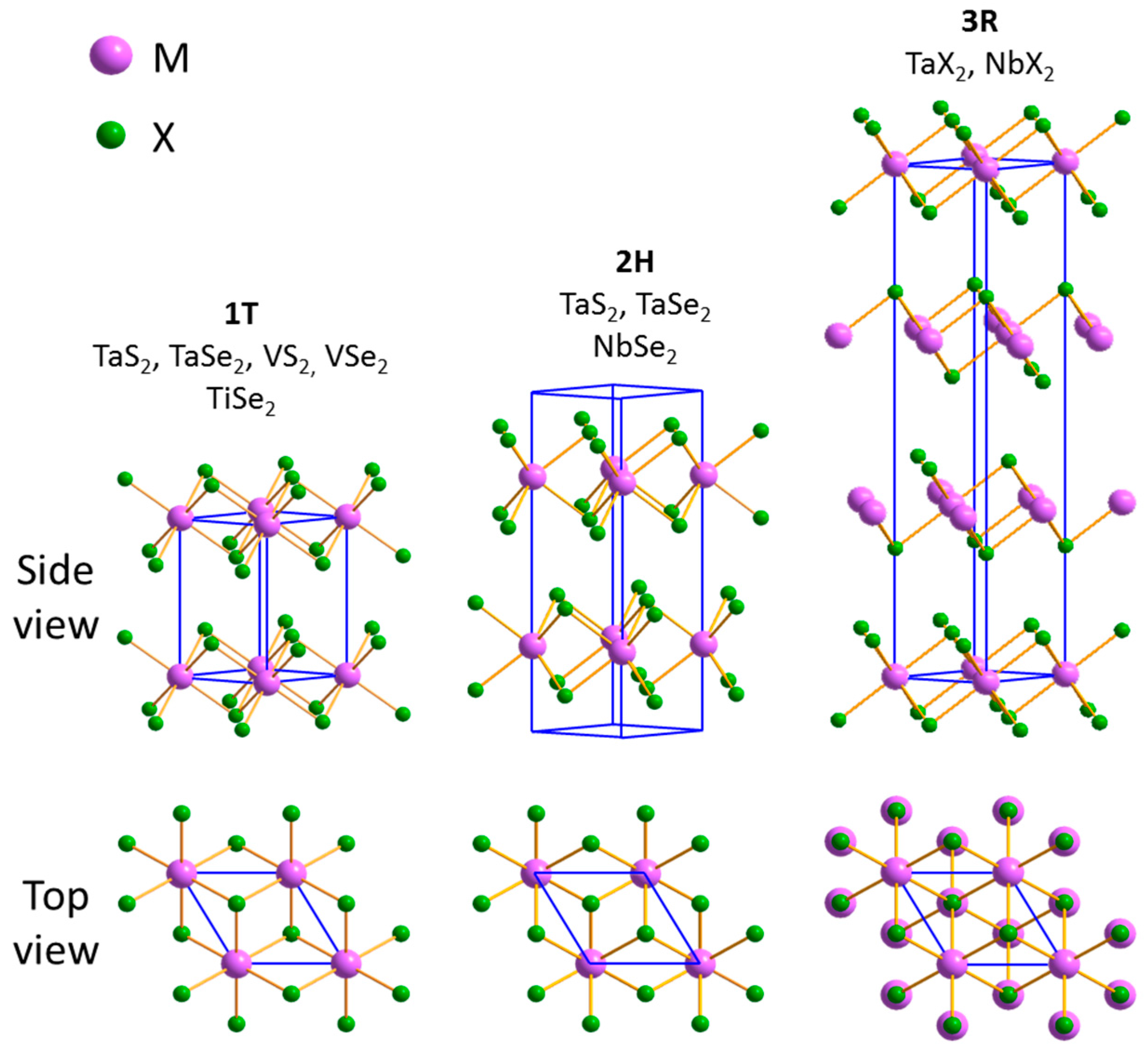
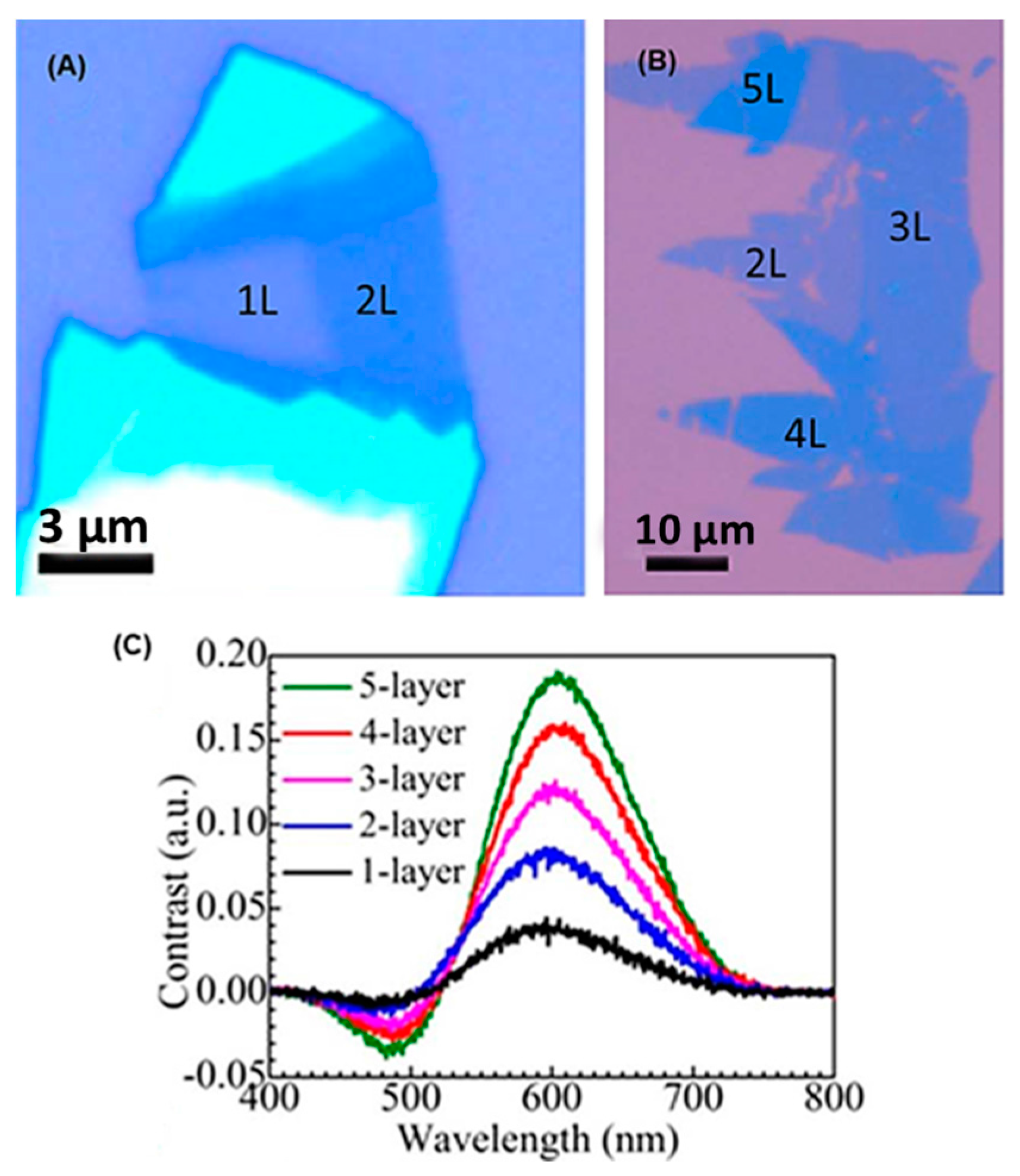
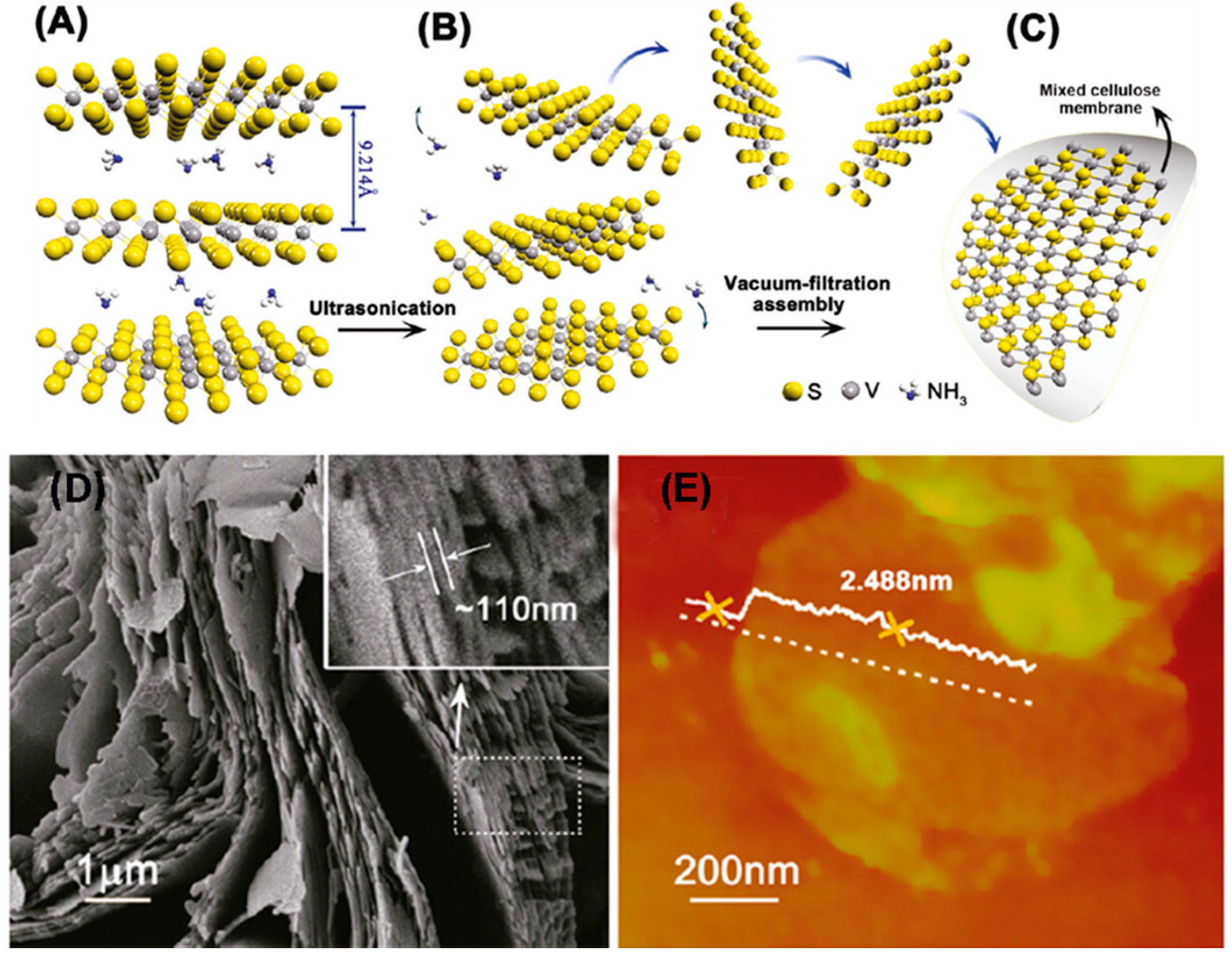
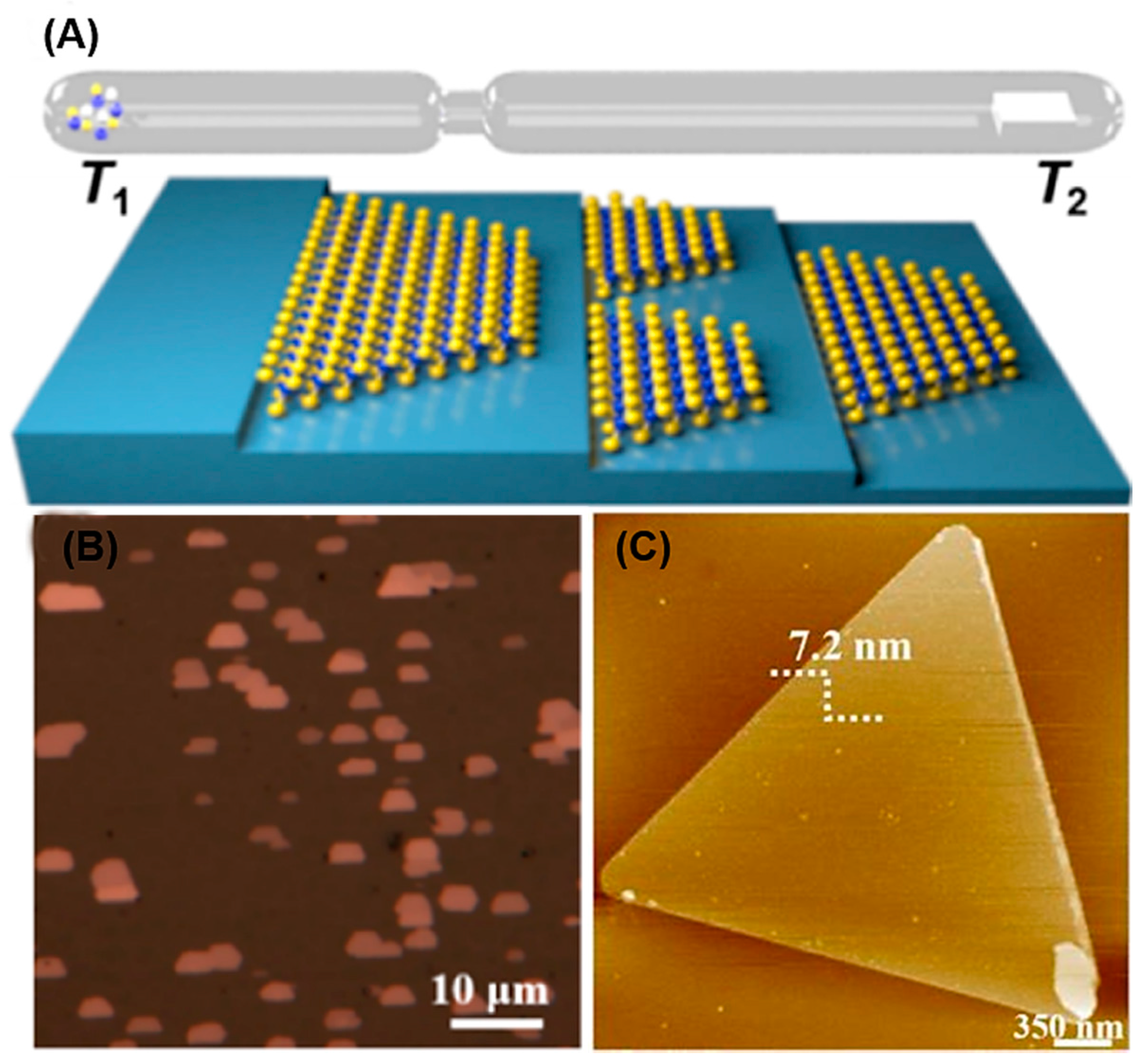
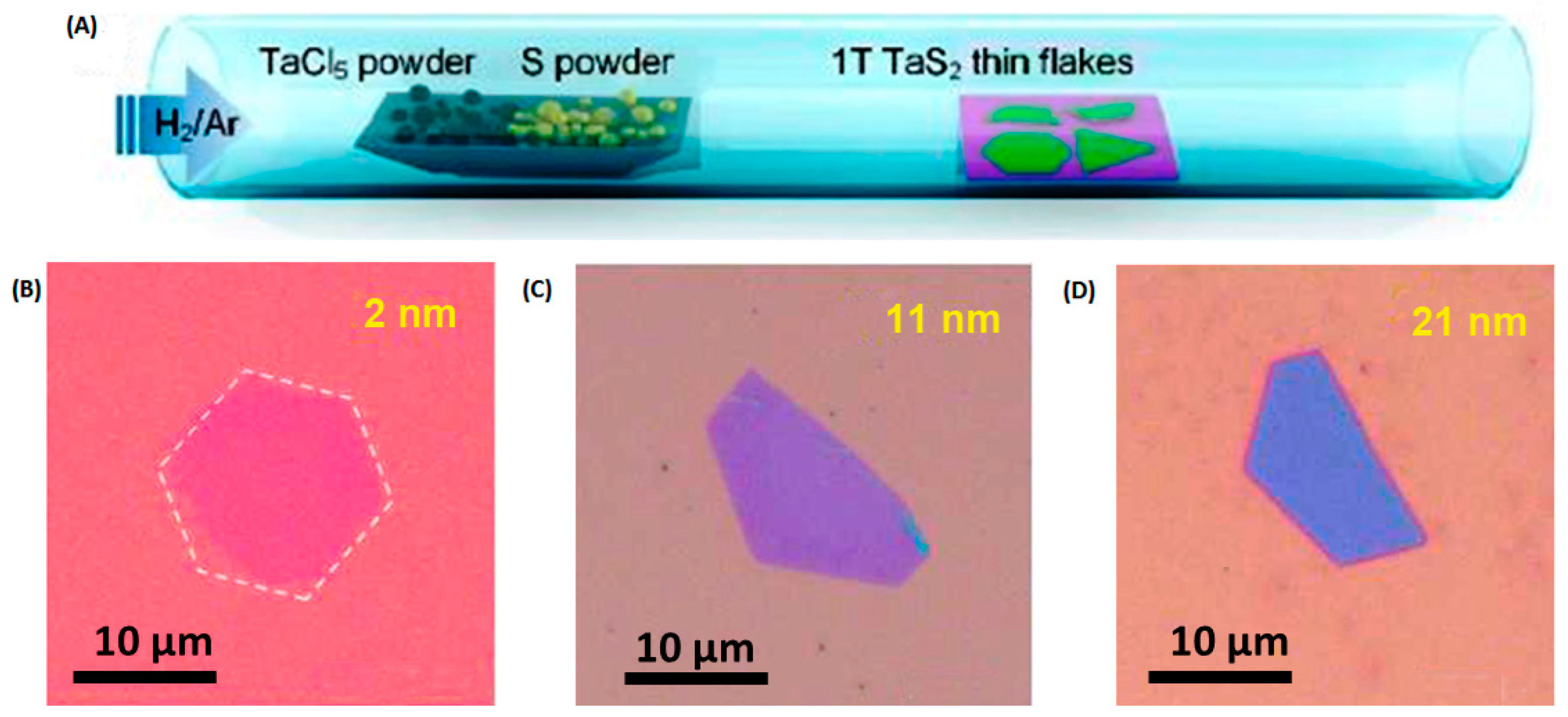

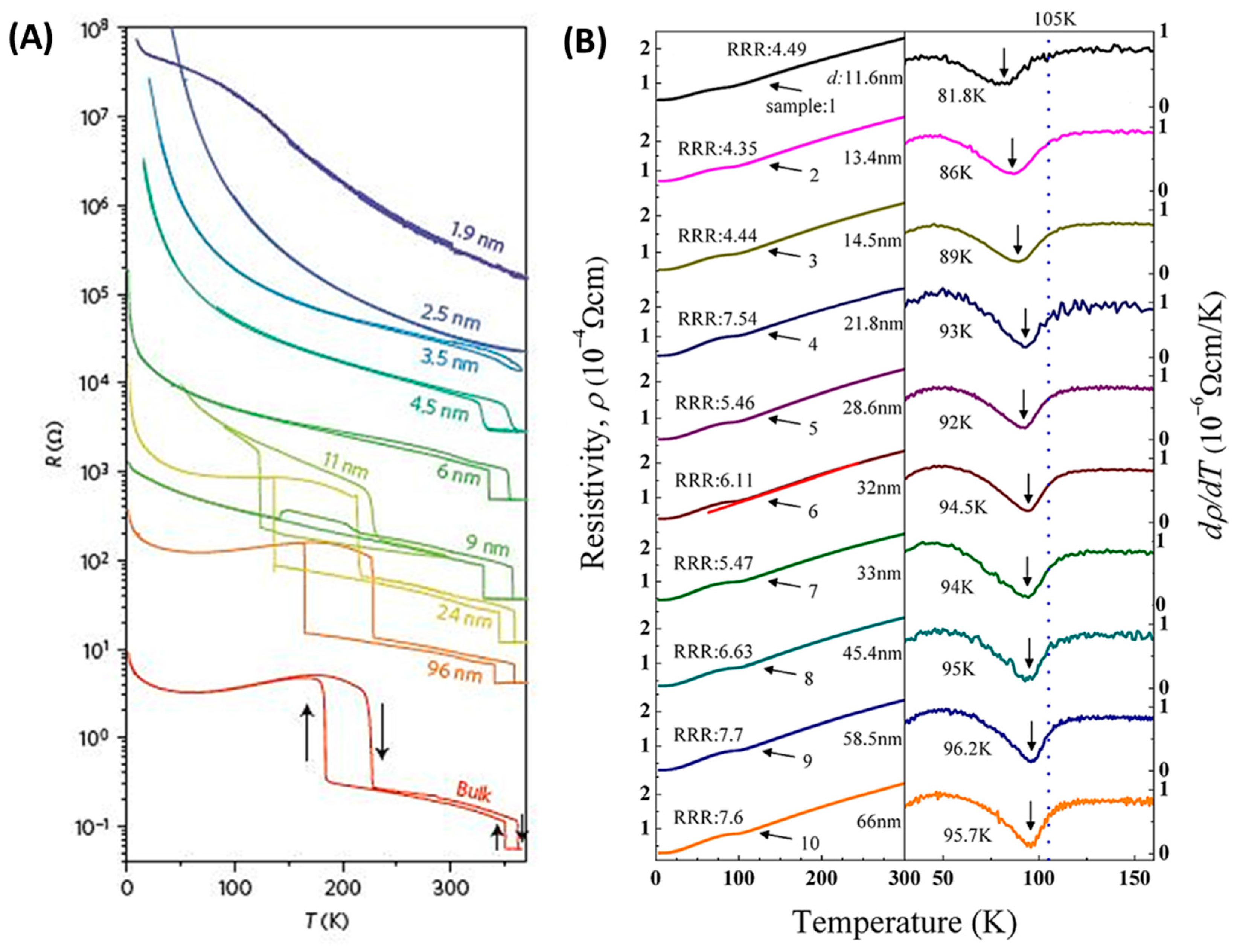
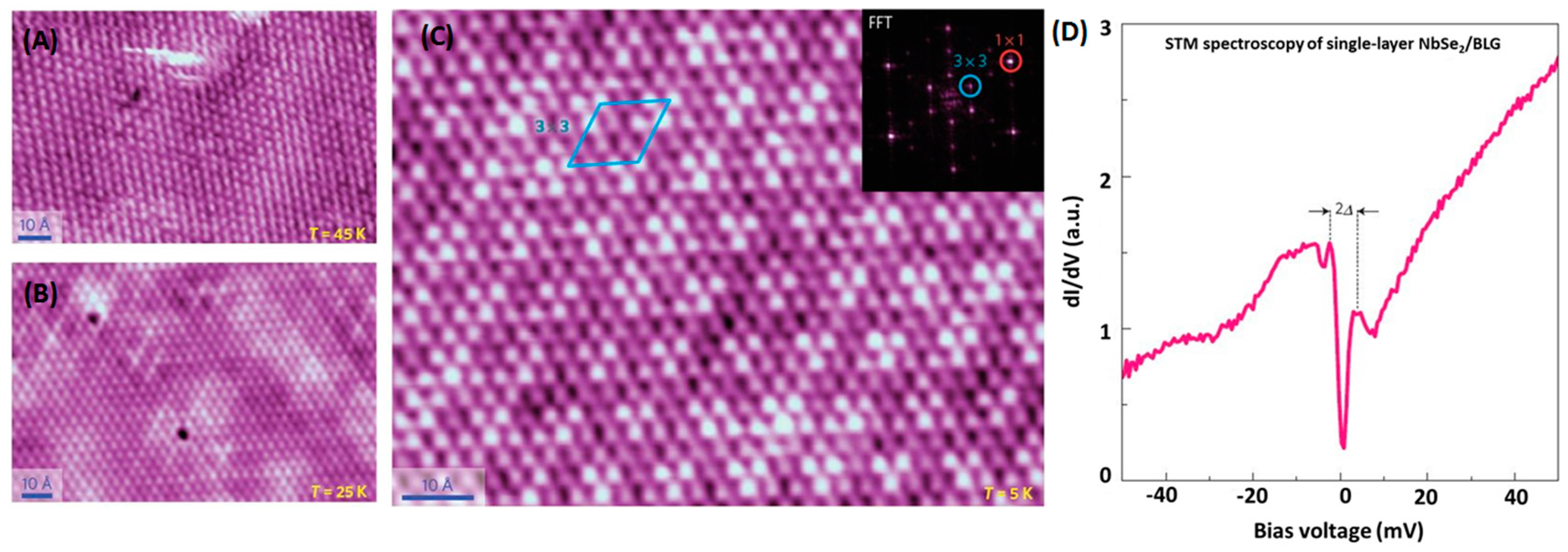

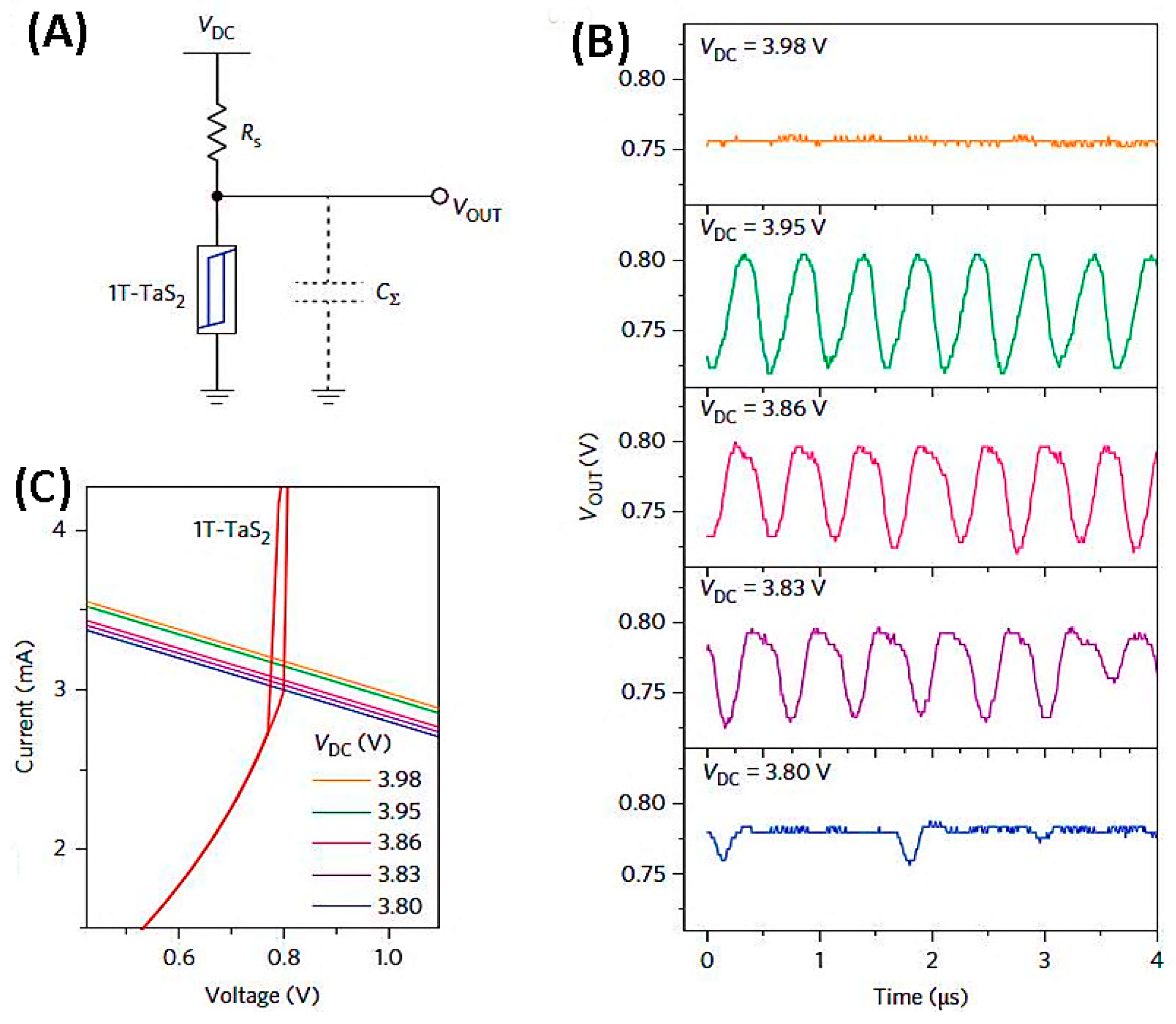
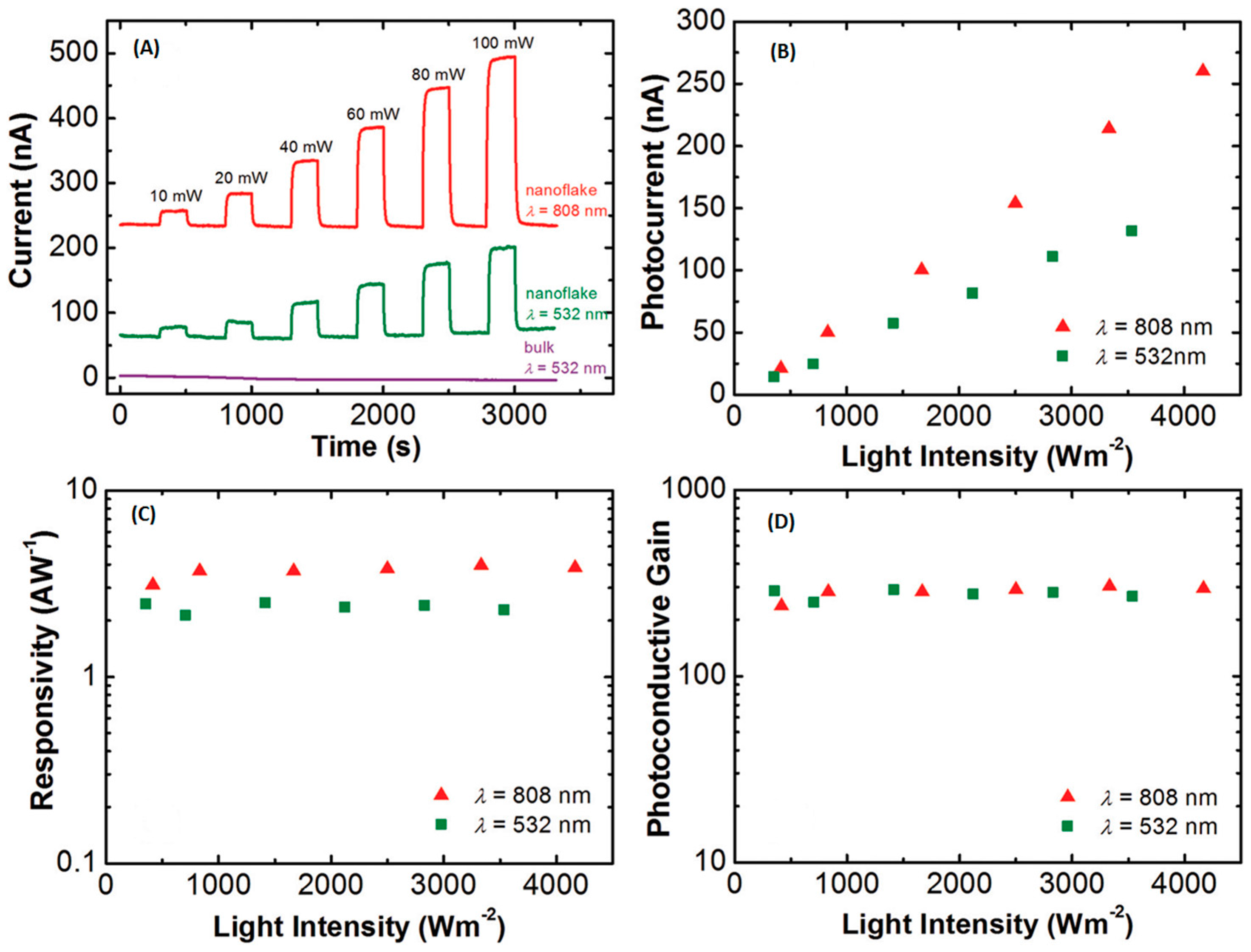

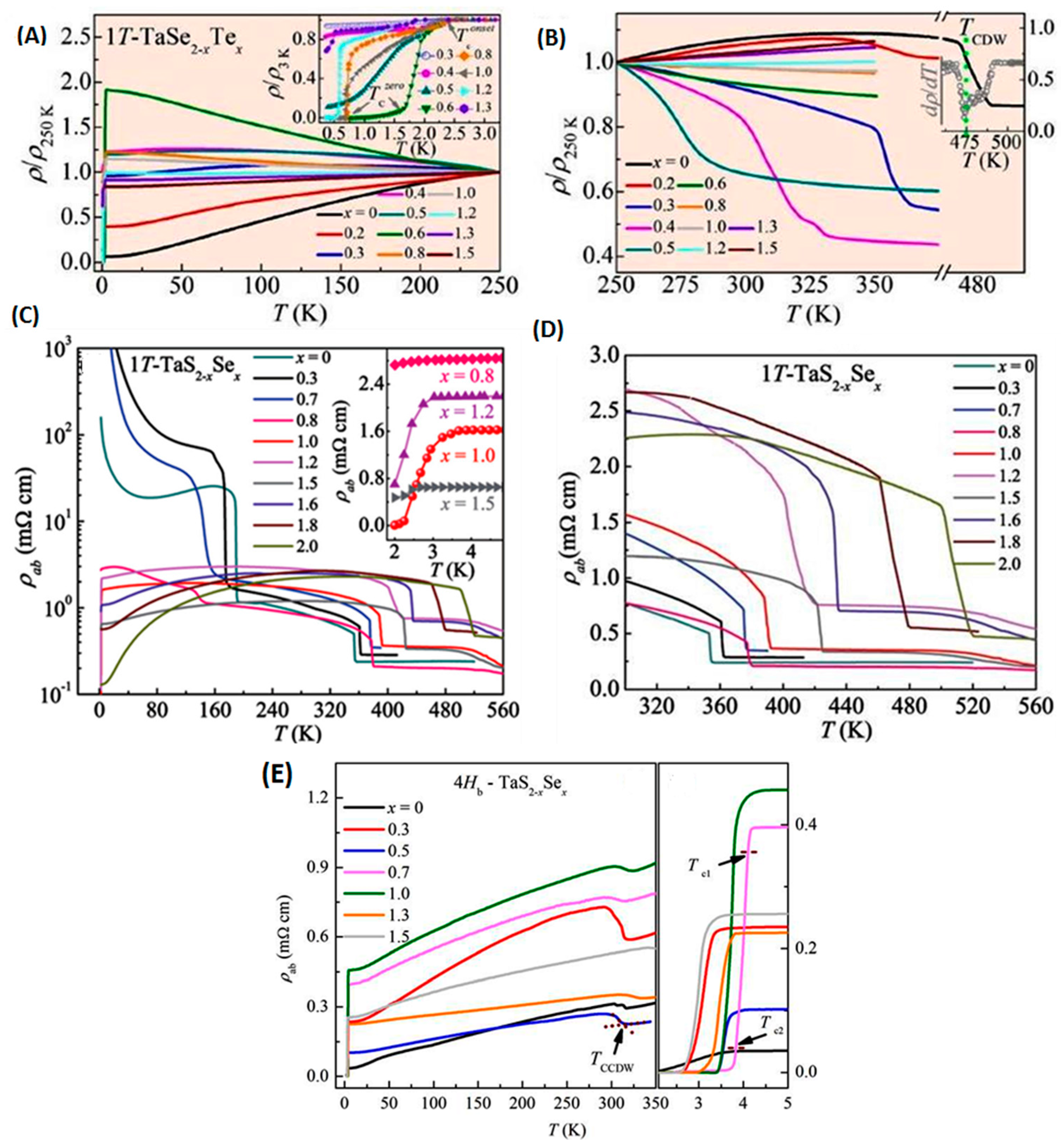
| Bulk Materials | Phase | Superconductivity Transition Temperature (TC) | CDW Transition Temperature (TCDW) and Structure | Crystal Phase Transition Temperature |
|---|---|---|---|---|
| VS2 | 1T | -- | ~305 K [21] | -- |
| VSe2 | 1T | -- | ~107 K [4] | -- |
| NbS2 | 2H | 6 K [22] | No CDW phase transition [22,23] | 3R→2H 1123 K |
| 3R | -- | -- | ||
| NbSe2 | 2H | 7.2 K [24] | 35 K (3 × 3 structure) [24] | 3R→2H 1104 K |
| 3R | -- | -- | ||
| TaS2 | 1T | -- | C-CDW at 180 K NC-CDW at 350 K I-CDW at 550 K [25,26] | 2H→1T 1300 K |
| 2H | 0.8 K [27] | 75 K [25] | ||
| TaSe2 | 1T | -- | C-CDW at 473 K (√13×√13 structure) I-CDW at 600 K [28] | 2H→1T 1111 K |
| 2H | 0.15 K [29] | C-CDW at 90 K (3 × 3) structure) I-CDW at 123 K [30,31] | ||
| TiSe2 | 1T | -- | ~200 K (2 × 2 structure) [11] | -- |
© 2017 by the authors. Licensee MDPI, Basel, Switzerland. This article is an open access article distributed under the terms and conditions of the Creative Commons Attribution (CC BY) license (http://creativecommons.org/licenses/by/4.0/).
Share and Cite
Hossain, M.; Zhao, Z.; Wen, W.; Wang, X.; Wu, J.; Xie, L. Recent Advances in Two-Dimensional Materials with Charge Density Waves: Synthesis, Characterization and Applications. Crystals 2017, 7, 298. https://doi.org/10.3390/cryst7100298
Hossain M, Zhao Z, Wen W, Wang X, Wu J, Xie L. Recent Advances in Two-Dimensional Materials with Charge Density Waves: Synthesis, Characterization and Applications. Crystals. 2017; 7(10):298. https://doi.org/10.3390/cryst7100298
Chicago/Turabian StyleHossain, Mongur, Zhaoyang Zhao, Wen Wen, Xinsheng Wang, Juanxia Wu, and Liming Xie. 2017. "Recent Advances in Two-Dimensional Materials with Charge Density Waves: Synthesis, Characterization and Applications" Crystals 7, no. 10: 298. https://doi.org/10.3390/cryst7100298






